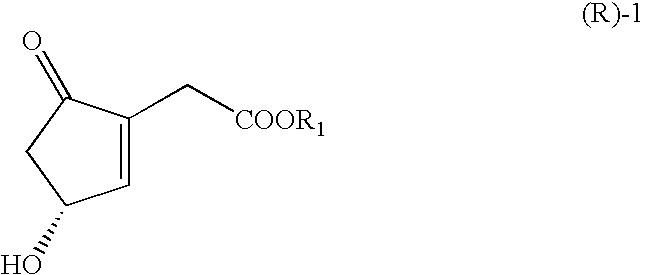Processes for the preparations of optically active cyclopentenones and cyclopentenones prepared therefrom
a technology of optically active cyclopentenones and preparations, which is applied in the field of optically active cyclopentenones and cyclopentenones preparations, can solve the problems of wasting about a half of the compounds that existed as unwanted isomers, difficult separation of them from each other, and uneconomical beraldi methods, etc., and achieves a higher crystallinity of optically active compounds. , the effect of convenient practi
- Summary
- Abstract
- Description
- Claims
- Application Information
AI Technical Summary
Benefits of technology
Problems solved by technology
Method used
Image
Examples
example 1
2-Ethoxycarbonylmethyl-4-hydroxy-2-cyclopenten-1-one
[0048]
[0049] The example was conducted according to the procedure shown in Scheme B.
Step (a):
[0050] A reaction flask (2-litter) was flame dried under vacuum and set under nitrogen. 400 ml of anhydrous THF, 59.68 g of diisopropylamine, and about 352 ml of 1.6 M n-butyl lithium in hexane were introduced into the reaction flask and stirred under a temperature ranging from −20° C. to 0° C. for about one hour. Subsequently, the reaction temperature was lowered to about −70° C. using a dry ice / acetone bath. A solution of ethyl acetate (47.2 g) diluted in 100 ml THF was added with a dropping funnel to the reaction mixture. 51.5 g of furfural was then added to the reaction mixture, and upon completion of the reaction, the reaction mixture was quenched by a saturated aqueous solution of ammonium chloride and then stirred for one hour. Upon completion, the phases were separated and the aqueous phase was extracted twice with ethyl acetate...
example 2
2-Methoxycarbonylmethyl-4-hydroxy-2-cyclopenen-1-one
[0053]
[0054] The procedure of Example 1 was repeated except that methyl acetate (40 g) was used instead of ethyl acetate. The titled compound was obtained in the form of dark oil (24 g). 1H-NMR (CDCl3 / TMS): δ 7.45 (s,1H), 5.01 (m, 1H), 3.72 (s, 3H), 3.28 (s,2H), 2.85 (dd, 1H), 2.35 (dd, 1H), 1.67 (brs, 1H).
example 3
2-Benzoxycarbonylmethyl-4-hydroxy-2-cyclopenten-1-one
[0055]
[0056] The procedure of Example 1 was repeated except that benzyl acetate (80.8 g) was used instead of ethyl acetate. The titled compound was obtained in the form of dark oil (55 g). 1H-NMR (CDCl3 / TMS): δ 7.15˜7.55 (m, 6H), 5.17 (s, 2H), 5.01 (m, 1H), 3.31 (s,2H), 2.83 (dd, 1H), 2.33 (m, 1H).
PUM
| Property | Measurement | Unit |
|---|---|---|
| optical purity | aaaaa | aaaaa |
| optical purity | aaaaa | aaaaa |
| optical purity | aaaaa | aaaaa |
Abstract
Description
Claims
Application Information
 Login to View More
Login to View More - R&D
- Intellectual Property
- Life Sciences
- Materials
- Tech Scout
- Unparalleled Data Quality
- Higher Quality Content
- 60% Fewer Hallucinations
Browse by: Latest US Patents, China's latest patents, Technical Efficacy Thesaurus, Application Domain, Technology Topic, Popular Technical Reports.
© 2025 PatSnap. All rights reserved.Legal|Privacy policy|Modern Slavery Act Transparency Statement|Sitemap|About US| Contact US: help@patsnap.com



